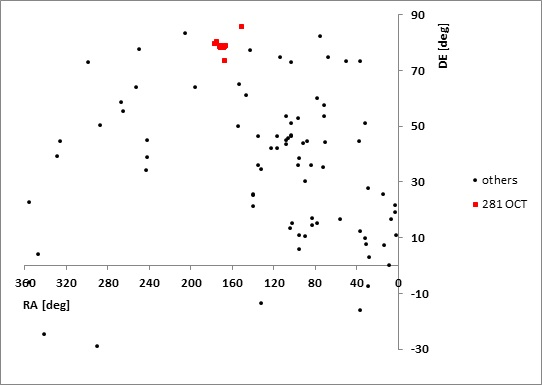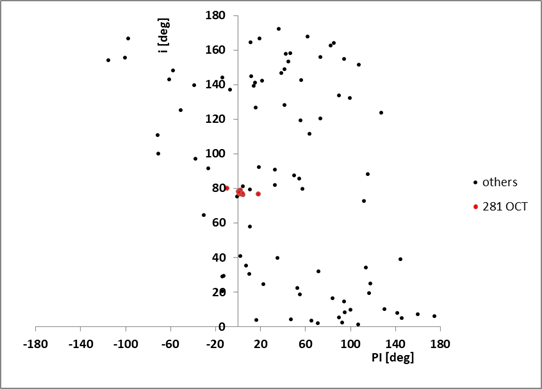CAMS BeNeLux collected 15 meteors belonging to a minor stream called the October Camelopardalids, (281 OCT) during routine CAMS observations on October 5, 2017. Radiant positions and orbital elements are in good agreement with previously reported results.
1 Introduction
The weather in the first week of October 2017 was very unstable, so it is no surprise that our network could collect no more than 380 orbits during the few clear spells. Fortunately, October 5–6 was the best night for observing in this week. During this night 18 of the 21 stations had at least longer clear periods. They collected 99 orbits in this single night.
2 History
In the course of the last century, observers noticed meteor activity from a region near the northern celestial pole, for instance in 1902, 1942 and 1976.
On October 5, 2005 some video-observers in Finland (Moilanen, Yrjölä and Lyytinen) and Germany (Molau) captured several bright meteors from a radiant near the border of the constellations Draco and Camelopardalis. Moilanen captured 19 meteors in the period 17h06m– 22h41m UT. Twelve of them shared the same radiant. Most of these meteors appeared between 17h and 20h UT (Jenniskens et al., 2005).
The mean radiant of these twelve meteors was calculated at RA = 164.1 ± 2.0 degrees and DE = 78.9 ± 0.5 degrees with a geocentric velocity of Vg = 46.9 ± 2.6 km/s. The mean orbital elements are summarized in Table 1.
According to Jenniskens et al. (2005), this stream is debris from a yet unknown long periodic comet, although because of the uncertainty on the semi major axis a Halley type comet cannot be excluded as possible option.
Esko Lyytinen forecasted higher activity for this stream at 14h45m UT of October 5 2016. Indeed, CAMS California captured 9 meteors that could be matched with this stream between 08h45m and 13h15m UT. CAMS UAE could add three more candidates between 14h48m and 19h15m UT. Finally, CAMS BeNeLux added four more candidates until 22h00m UT.
The orbital elements for these meteors are also listed in Table 1.
For 2017, Esko Lyytinen forecasted enhanced activity at October 5th, 20h47m UT, although possibly at a lower level than in 2016, due to a greater distance between the dust trail and the Earth this year.
3 Processing the 2017 data
While processing the data of October 5–6, a cluster of radiants became visible near RA = 170 degrees and
DE = 74 degrees.
A total of 15 meteors showed orbital elements in good agreement with the now so called October Camelopardalids (281 OCT). Six of these OCTs appeared between 18h and 19h UT. The other nine members appeared between 19h and 24h UT.
Figure 1 shows the radiant positions of all captured simultaneous meteors during the night of October 5–6. The OCTs are marked with a red colored square in this plot. They appear as a striking compact radiant.
The D-criterion for 13 out of these 15 OCTs is < 0.05. OCTs with the highest and lowest declination in this plot have a Dd in the interval 0.08 – 0.09, just below the limit of Drummond’s D-criterion (Drummond, 1981).

Figure 1 – Radiantplot for 2017 October 5; red squares mark the 281 OCT meteor radiants.
Figure 2 shows a plot of the orbital elements PI, length of perihelion, against i, the inclination. Again a striking compact picture appears. The OCTs with Dd > 0.05 are the ones with the lowest and highest value of PI.

Figure 2 – Plot of the length of perihelion PI against inclination i for 2017 October 5; 281 OCTs are marked in red.
Table 1 shows the mean orbital elements of OCTs in Jenniskens et al. (2005)1 and our data in 2017.
Table 1 – The orbital elements of the 281 OCT meteors.
| Jenniskens et al. (2005) | Jenniskens[1] | 2017 CAMS BeNeLux | |
| q (UA) | 0.993±0.001 | 0.990±0.005 | 0.991±0.006 |
| e | – | 0.93±0.08 | 0.948±0.05 |
| i(°) | 78.3±0.5 | 77.1±1.0 | 77.6±2.3 |
| ω (°) | 170.5±1.0 | 168.2±2.5 | 169.4±4.1 |
| Ω (°) | 192.59±0.04 | 192.41±0.15 | 192.35±0.25 |
[1] https://www.seti.org/seti-institute/news/october-5-outburst-october-camelopardalids
4 Conclusion
Untill 2016 we could not find any member of this stream in the CAMS BeNeLux data. In 2016 and 2017 this stream is clearly visible in our data.
In 2017 the highest activity seems to have occurred between 18h and 19h UT, more than one hour earlier than predicted. However, we should keep in mind that our network cannot start collecting data before 17:30 UT (eastern parts of the Netherlands) around this time in October. Higher activity before 18h UT cannot be excluded and may have been missed by our network.
Acknowledgments
Thanks to Reinder Bouma for his critical comments on this article.
We thank all CAMS stations for their quick processing of all data:
Hans Betlem (Leiden, CAMS 371, 372 and 373), Felix Bettonvil (Utrecht, CAMS 376 and 377) , Jean-Marie Biets (Wilderen, CAMS 380, 381 and 382), Bart Dessoy (Zoersel, CAMS 397, 398, 804, 805 and 806), BISA / Hervé Lamy (Dourbes / Ukkel, CAMS 394 and 395/ 393), Martin Breukers (Hengelo, CAMS 320, 321, 322, 323, 324, 325, 326 and 327), Franky Dubois (Langemark, CAMS 386), Jean-Paul Dumoulin/ Christian Wanlin (Grapfontaine OCA, CAMS 814 and 815), Luc Gobin (Mechelen, CAMS 390, 391, 807 and 808), Robert Haas (Alphen aan de Rijn, CAMS 360, 361, 362, 363, 364, 365, 367 and 368; Texel, 810, 811 and 812), Robert Haas / Edwin van Dijk (Burlage, CAMS 801 and 802), Klaas Jobse (Oostkapelle, CAMS 330, 331, 332, 333, 334, 337, 338 and 339) , Carl Johannink (Gronau, CAMS 311, 312, 313, 314, 315, 316, 317 and 318), Koen Miskotte (Ermelo, CAMS 351, 352, 353 and 354), Piet Neels (Ooltgensplaat, CAMS 340, 341, 342, 343, 344, 345, 349 and 840; Terschelling, 841, 842, 843 and 844), Steve Rau (Zillebeke, CAMS 385 and 387), Paul Roggemans (Mechelen, CAMS 383, 384, 388, 389, 399 and 809), Hans Schremmer (Niederkruechten, CAMS 803) and Erwin van Ballegoij (CAMS 347 and 348).
References
Drummond J. D. (1981). “A test of comet and meteor shower associations”. Icarus, 45, 545–553.
Jenniskens P., Moilanen J., Lyytinen E., Yrjölä I., Brower J. (2005). “The 2005 October 5 outburst of October Camelopardalids”. WGN, Journal of the IMO, 33, 125–128.
Jenniskens P., Gural P. S., Dynneson L., Grigsby B. J., Newman K. E., Borden M., Koop M. and Holman D. (2011). “CAMS: Cameras for Allsky Meteor Surveillance to establish minor meteor showers”. Icarus, 216, 40–61.
Jenniskens P., Nénon Q., Albers J., Gural P. S., Haberman B., Holman D., Morales R., Grigsby B. J., Samuels D. and Johannink C. (2016). “The established meteor showers as observed by CAMS”. Icarus, 266, 331–354.





